News & Articles
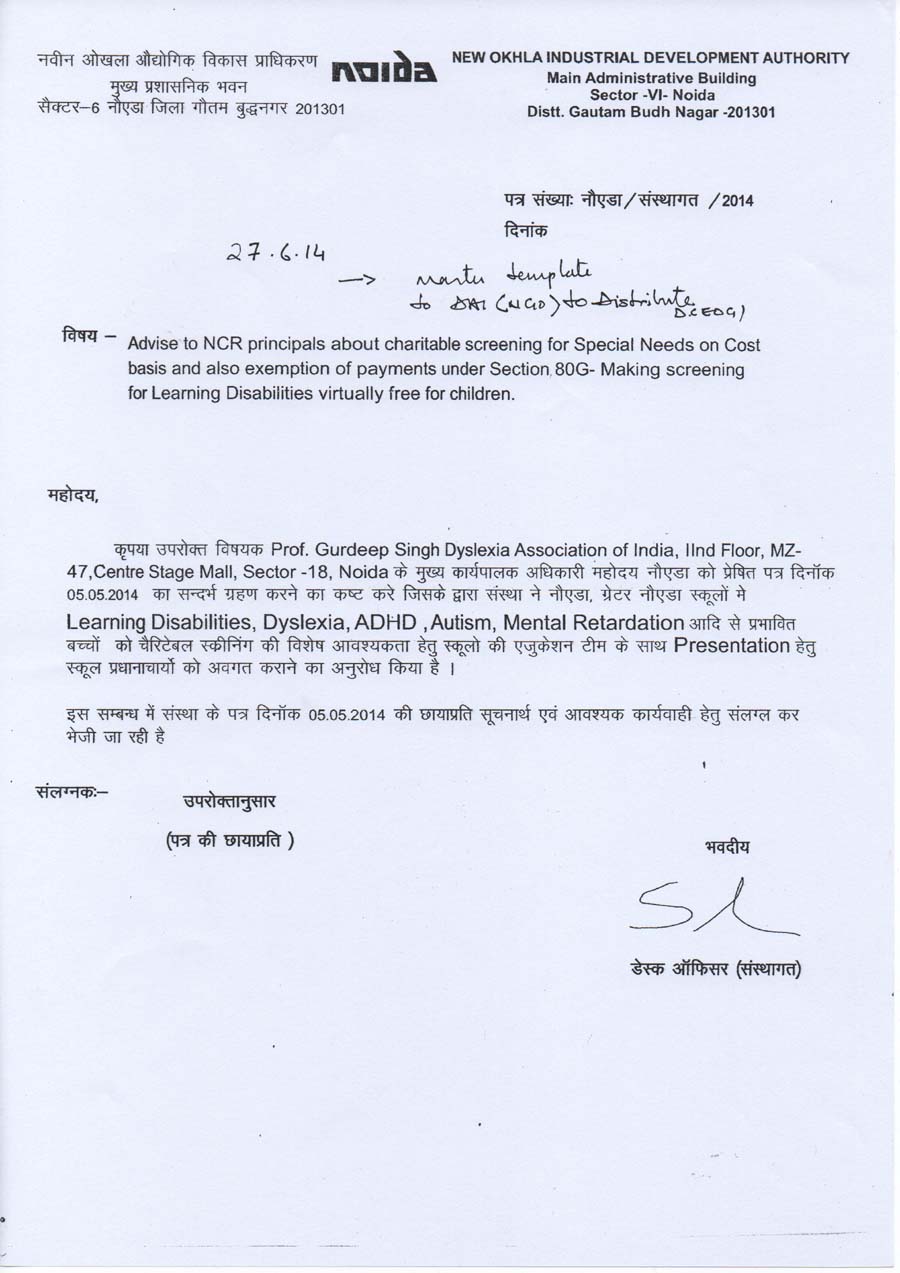
CBSE Schools in Noida
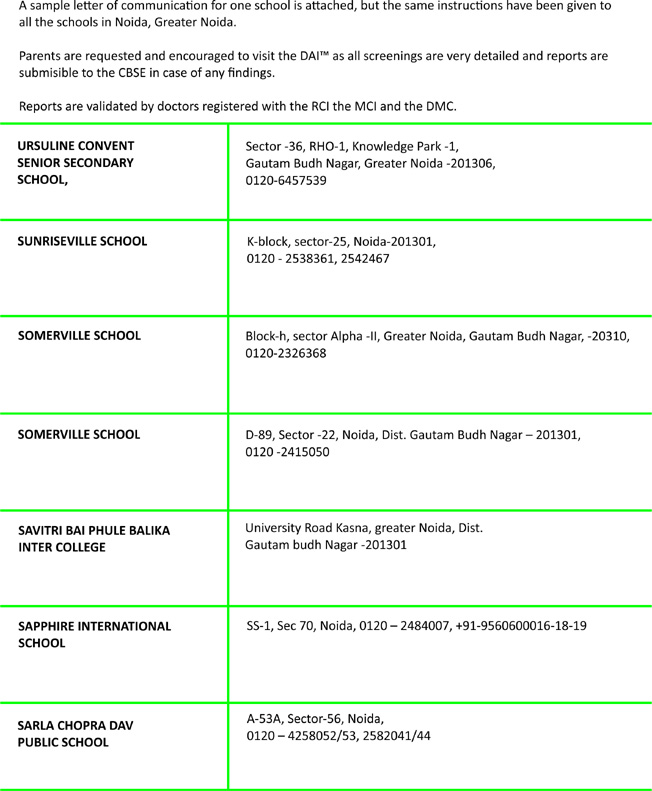
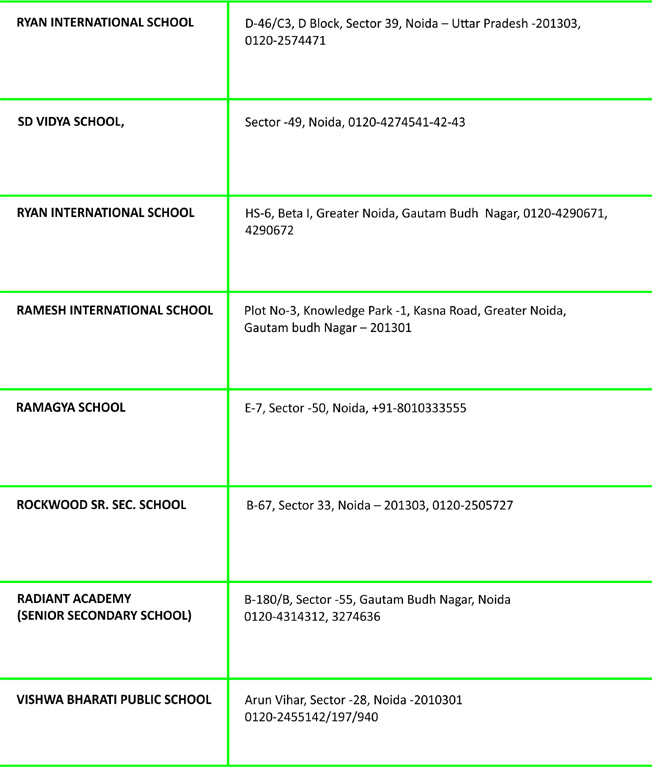
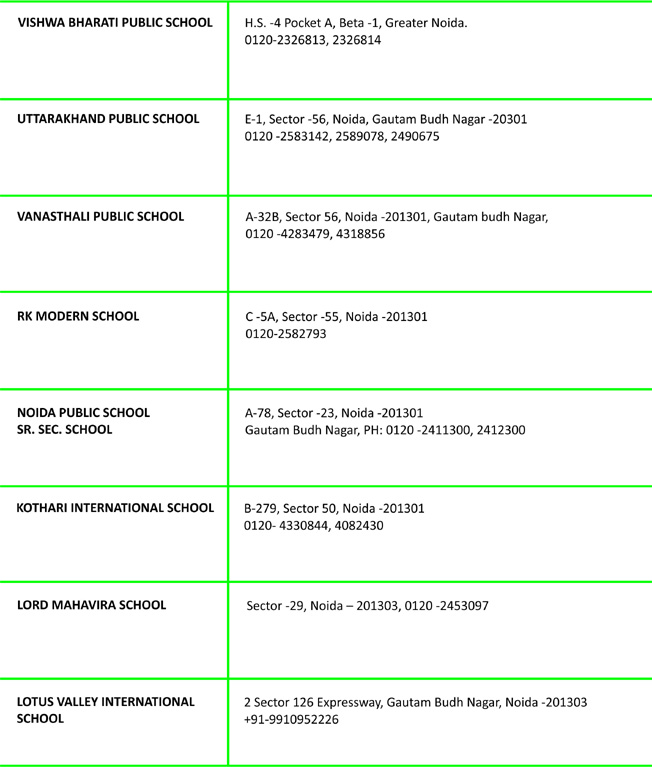
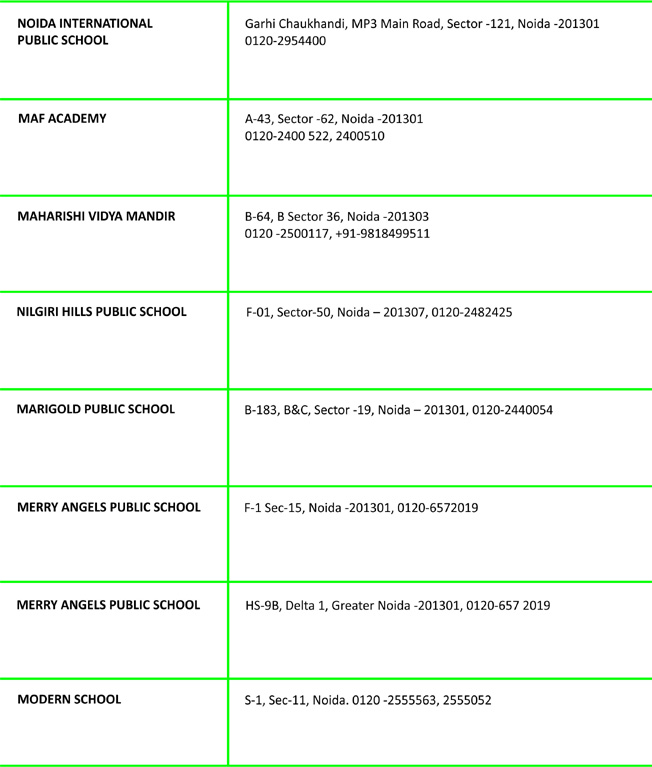
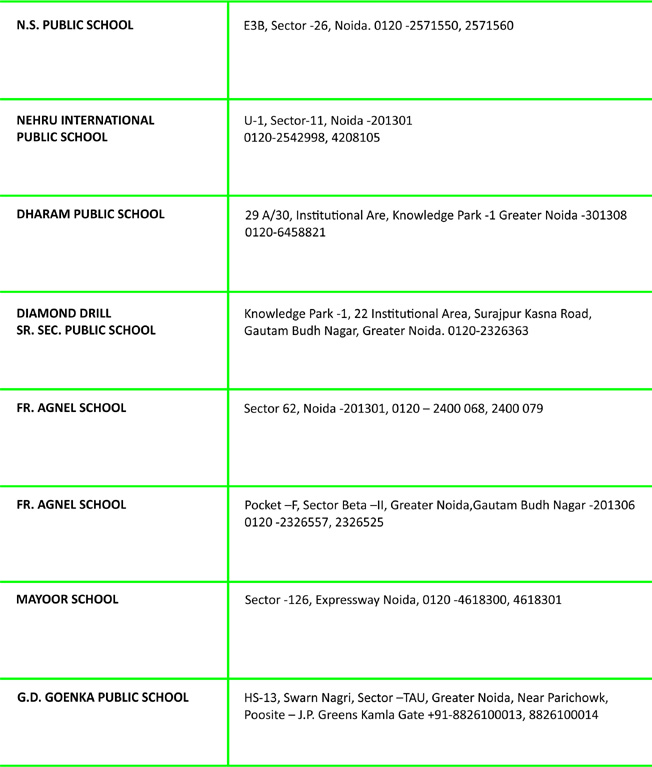
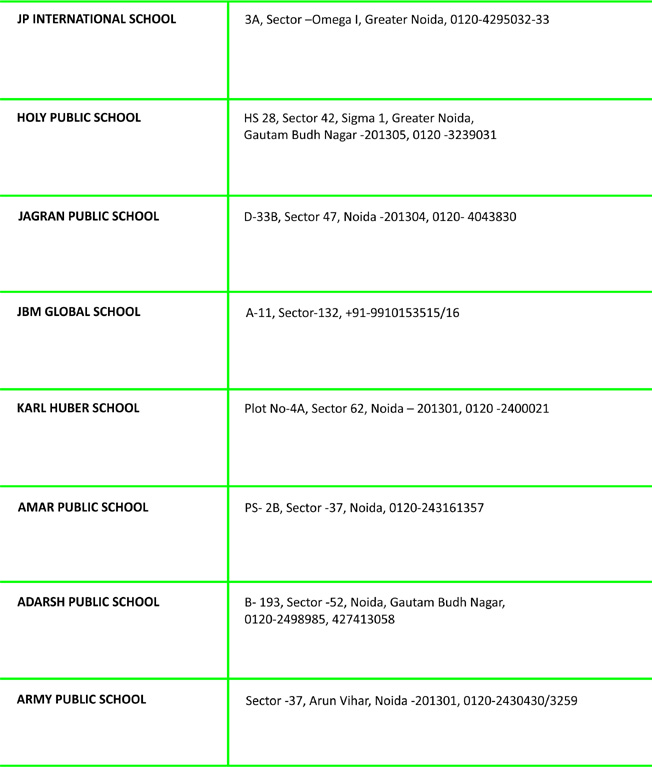
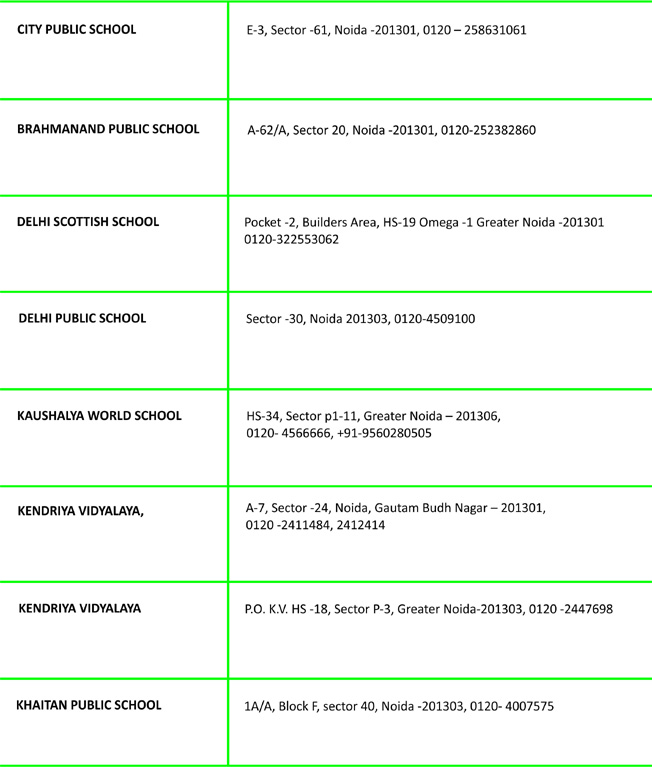
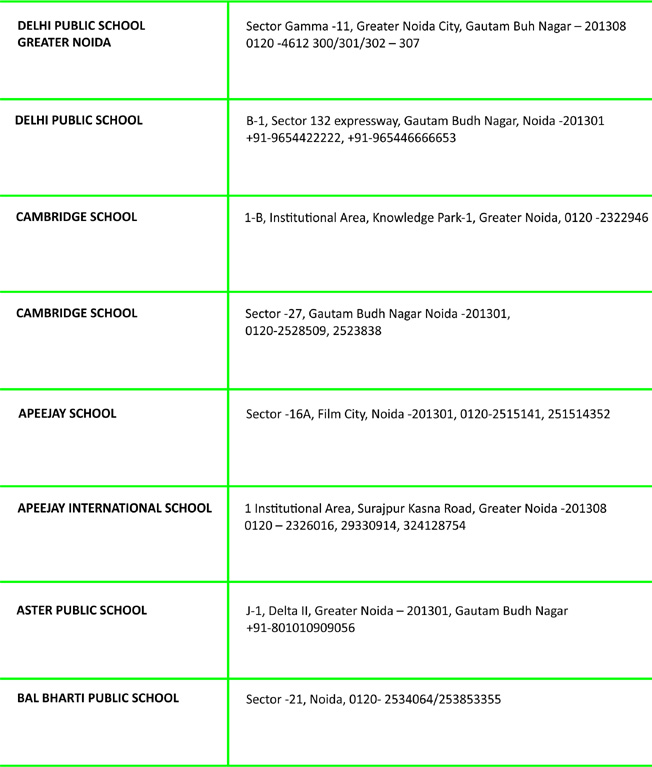
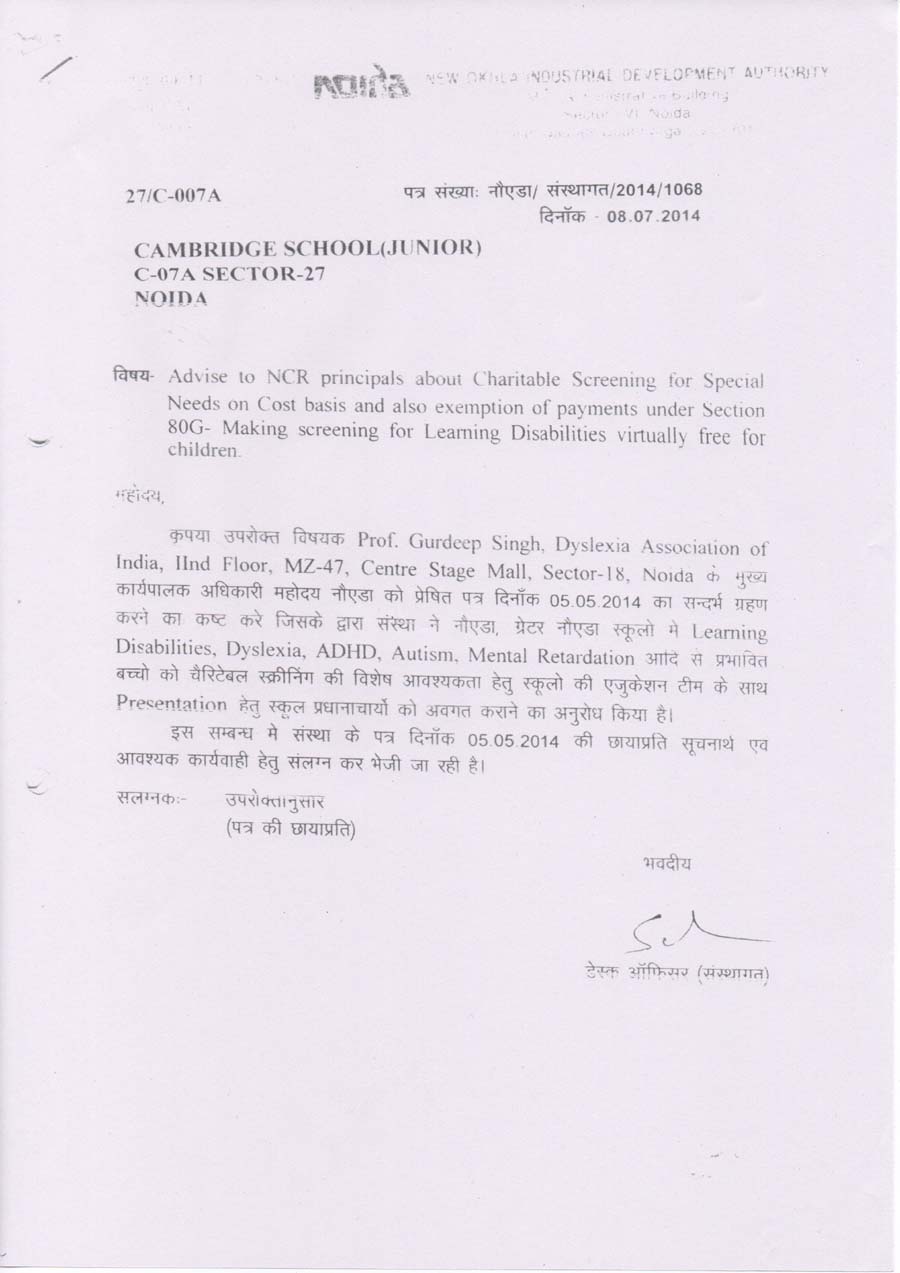
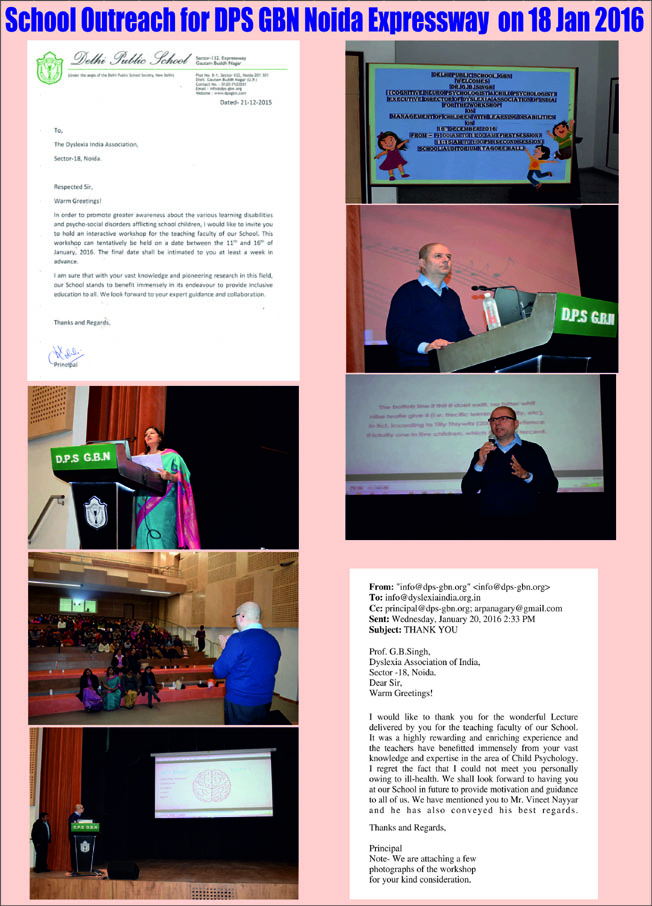
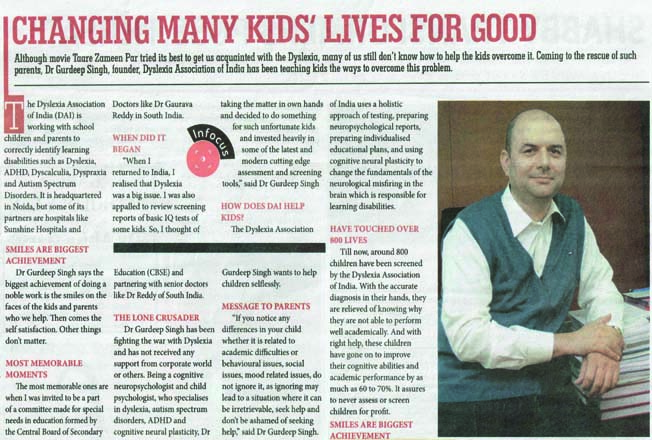
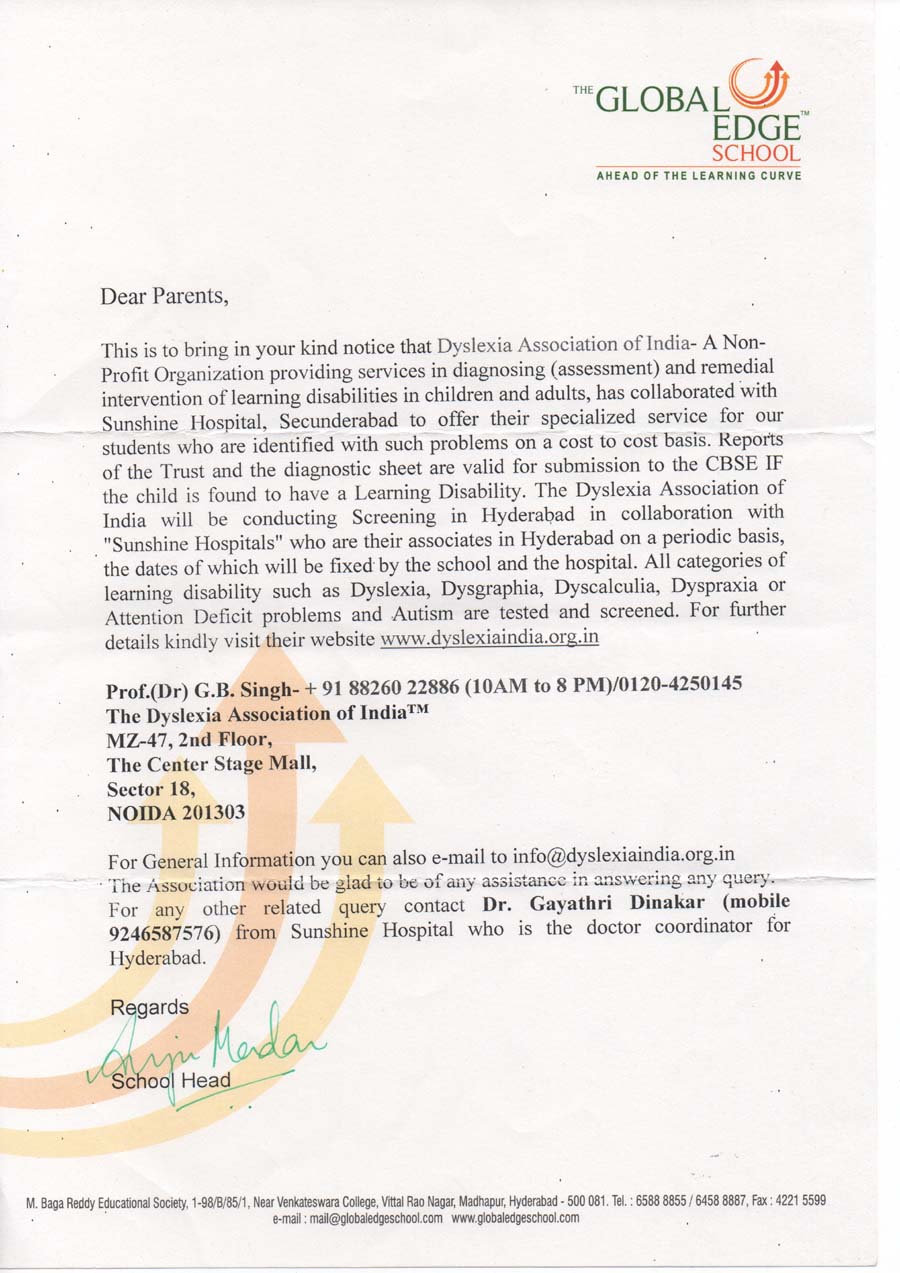


City Plus , 14 August 2013
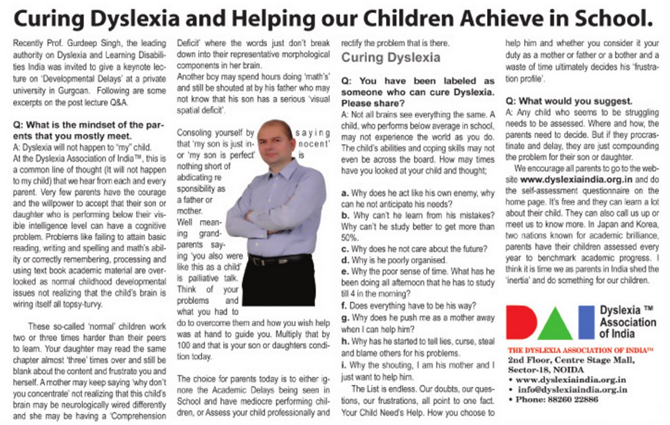
Help for Dyslexic Children from the C.B.S.E
Help for Dyslexic Children from the C.B.S.E Working behind the scenes, the Central Board of Secondary Education headed by Mr. Vineet Joshi is working tirelessly to assist and alleviate the problems caused by Learning Disabilities amongst our children.
A considerable number of parents ask-‐ what is the C.B.S.E doing?
It may come as a surprise, but the C.B.S.E is clued on to the latest developments in the field of Learning Disorders. its Senior level staff are constantly reviewing and ascertaining what more they can do to provide situational and academic scaffolding for children who have been assessed correctly and where the school principal has forwarded a request for certain exemptions.
When we compare a small country like the United Kingdom to the size of the student population in India, we must also appreciate the size of the task that the officials of the C.B.S.E face. The multilingualism and the attempt to create a common platform for integrative understanding of the various form of Learning Disorders that can manifest in today’s world -‐ given the multitude of genetic recombination’s possible as the number of souls increase creates a fertile ground for newer and complex Learning Disorders being discovered on a routine basis.
The Dyslexia Association of India™ supports the efforts of the dedicated team of officials who strive tirelessly and would encourage that parents must ensure and professionals must implement best practices for assessment and categorization of students as being ‘Dyslexic’ or not.
We must remember that provisions are there for children who may have a genuine neurological problem with cognitive functioning. Provisions must be sought on factual data and in depth understanding of any particular child.
The value of trust and integrity must be imbibed as this nascent field expands its understanding of the complexity of problems and the effort that the C.B.S.E is doing to help children. Correct diagnosis and requests for exemption are very crucial to make sure that the genuinely affected child is helped.
With this in mind, parents may find the below listed options fruitful for their understanding of how their child’s school can help their learning disabled child.





 Training the Brain
Training the Brain
Reading and writing have to be learnt, as we are not hardwired to automatically glide into the process of the acquisition of a specific language.
A significant number of children who display comparatively poor reading and writing (spelling) abilities have been known to show increased activation in the frontal medial and the right hemisphere regions of their brains. Correspondingly, during the processing of a lexical decision task, these children demonstrate
decreased activation in the left occipito – temporal regions of their brains.
A crucial question is whether ‘Educational Remediation’ that we provide to children with reading and spelling difficulties has any impact on their ‘Neural Networks’, and whether the targeted intervention has the possibility to alter the brain function in the Language relevant networks.
While much research is ongoing on the subject, it has been observed that children who do not display any Grapheme-Phoneme Conversion Deficits in tasks of reading and spelling have a higher activation in the Left Hemisphere of their Brain, which comprises the Visual Word Form Area.
Targeted and evidence based Remedial Intervention of children by the Dyslexia Association of India™ has demonstrated significant improvement in the reading and spelling ability of the children who attend these intervention classes on a Bi- Weekly basis.
Just as the famed ‘Taxi Drivers’ of London have been reported to evolve new neural networks which have relevance for memory recollection, so the children who learn to apply Specific Cognitive Strategies during a Lexical Decision Task may also evolve alternative Neural Pathways that allow for increased activation in the Left Temporal, Parahippocampal and Hippocampal regions with time and dedication.
Enhanced reliance on concept retrieval, Semantic Processing and Integration Processes are the salient unseen processes, which are the outcomes of a successful targeted Intervention Programme.
We use Specific Neuro-Plasticity through the modality of targeted academic resources to achieve what has been described above. It is a myth that only a Dyslexic child needs help in ‘Learning to Read’, most children who are performing below the levels of expectation fall in the category where they can do with some scaffolding support so that their metacognition improves and they become fluent readers and learners.
For more information on how the Dyslexia Association of India™ can help your child become a better learner and swifter in his academic pursuits, please call our helpline 88260-22886. We would be glad to be of assistance and it does not cost anything except for your time.
City Plus , 11-17 March 2012
Noida


"The Turbocharged Space Rocket"
Is how mrs.C describe her son PC, who made this card for us
" PC is a 8 year old child who has been coming to the Dyslexia Association of India for remedial intervention for the last two months. Think of a spring coiled and ready to bounce all over the room and that is PC for you. It is an riot to watch PC function. When he sits down, his backpack will drop, when he bends to pick up the back pack, his pencils will fall out of his pocket, when he picks up his pencil, his writing book will skip on the floor, when all are in his lap, he will suddenly want to go to the washroom. When he comes back, the routine will follow all over again and we can not but help smile looking at him. PC has a serious case of Attention Deficit Disorder and a case of Dyspraxia or a Development Coordination Disorder. When he came to us two months ago, he did not know how to string the alphabet together. Going from A to Z was a 20 minute nightmare and the 'd' to 'b' and the 'i' to '1' were there right in your face.
After two months of targeted Neuro Plasticity and remedial - we cant say he is perfect, but he is getting there. The card speaks for itself. The 'Poem for you' which becomes a 'Poem of you' is a joy to read as it reaffirms the progress being made.
Have a look at the three dimensional figures. PC is a Visual Spatial Learner. See the beautiful Bear and Flower in three dimensional representations.
PC is a work in progress and going from zero to even 25% is a remarkable journey."
School Outreach for G.D. Goenka Public School Kakardooma
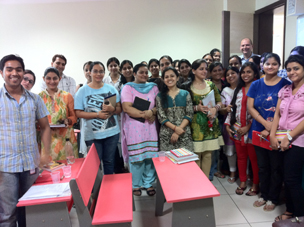 India is a multilingual country. Each area is as diverse as the dialect that is spoken in the specific area. When a child is born, the first sounds he or she hears are the sounds of the language that are being spoken by the grandparents and the parents. Doting mothers and father’s leave no stone unturned to baby speak to the child to make him or her feel loved. Generous doses of expressive language love from grandparents who may or may not speak the same dialect reach the baby’s brain as stimulus. In this onslaught of stimulus, the small child’s brain is constantly trying to recognize what sound symbolizes which meaning.
India is a multilingual country. Each area is as diverse as the dialect that is spoken in the specific area. When a child is born, the first sounds he or she hears are the sounds of the language that are being spoken by the grandparents and the parents. Doting mothers and father’s leave no stone unturned to baby speak to the child to make him or her feel loved. Generous doses of expressive language love from grandparents who may or may not speak the same dialect reach the baby’s brain as stimulus. In this onslaught of stimulus, the small child’s brain is constantly trying to recognize what sound symbolizes which meaning.
As human beings have not evolved with inbuilt language centers in their brain that just ‘switch’ on when some one begins to speak to them, they have to learn the sound that dad or mum is making to co-relate that sound
to a specific meaning. So commences a long drawn out process of learning the language spoken at home and in turn using it to form a two way communication process.
Now fast track to our school system. English is the primary medium of instruction and Hindi is the second language that most children have to learn. So we have tiny tots who come to school speaking and recognizing a mother tongue that their parents speak and their grandparent’s communicate in - and over night they have to learn a language or two they are not familiar with.
 India is a multilingual country. Each area is as diverse as the dialect that is spoken in the specific area. When a child is born, the first sounds he or she hears are the sounds of the language that are being spoken by the grandparents and the parents. Doting mothers and father’s leave no stone unturned to baby speak to the child to make him or her feel loved. Generous doses of expressive language love from grandparents who may or may not speak the same dialect reach the baby’s brain as stimulus. In this onslaught of stimulus, the small child’s brain is constantly trying to recognize what sound symbolizes which meaning.
India is a multilingual country. Each area is as diverse as the dialect that is spoken in the specific area. When a child is born, the first sounds he or she hears are the sounds of the language that are being spoken by the grandparents and the parents. Doting mothers and father’s leave no stone unturned to baby speak to the child to make him or her feel loved. Generous doses of expressive language love from grandparents who may or may not speak the same dialect reach the baby’s brain as stimulus. In this onslaught of stimulus, the small child’s brain is constantly trying to recognize what sound symbolizes which meaning.
As human beings have not evolved with inbuilt language centers in their brain that just ‘switch’ on when some one begins to speak to them, they have to learn the sound that dad or mum is making to co-relate that sound
to a specific meaning. So commences a long drawn out process of learning the language spoken at home and in turn using it to form a two way communication process.
Now fast track to our school system. English is the primary medium of instruction and Hindi is the second language that most children have to learn. So we have tiny tots who come to school speaking and recognizing a mother tongue that their parents speak and their grandparent’s communicate in - and over night they have to learn a language or two they are not familiar with.
School Outreach for DPS Mathura Road, New Delhi
When children struggle in school, parents often feel unsure of what to do or where to turn. The fact that you as a parent are not alone is the theme the Dyslexia Association of India wanted to communicate to the parents who had spared the time to meet us and learn from our presentation on 19th of May 2012 at DPS Mathura Road, New Delhi. In India One in four children require some form of special assistance in the learning process. Our message to the parents was that your child is lucky to have a parent like you who's looking for answers and advice. It takes a lot of effort to skip office or take an off to sit through a presentation for you child. But the payoff is substantially high and attending and meeting with professionals who work in this field can mean the difference between success in academics and life for the attending parents child. We are very grateful to the parents who came and to Astha a wonderful person who is so focused on helping children in her school succeed.
As parents we would like you to appreciate that general education and Special Education have the same goals. They have been implemented to help children become productive. The thrust of general education is to impart literacy and eventually allow for a grading system that will channelize children to their preferred subject of study. If this is so then Special Education is an individually based instruction programme for all children who may have a deficit in one area of academic functioning and be performing well enough in the other spheres. While the Dyslexia Association of India offers assessment and screening to identify all forms of Learning Differences be they Spelling, reading, mathematics, comprehension, memory, etc it also offers specialized remedial classes that are absolutely non profit. The thrust is to take advantage of the Neuro Plasticity of the brain of children and using correct instructional methods, and neurolinguistic programming techniques bring children up to grade level.
It may come as a surprise to parents but the fact is that once a child crosses class V, only about 15% of children can be brought up to grade level competencies if they can gain access to specialized and targeted intervention.
Our effort at the Dyslexia Association of India™ is to bring early screening to all children so that we can isolate potential weaknesses in the child which will impact on that child’s school based learning. It can take a long time to unlearn any incorrect habit developed and reinforced over time.
All children irrespective of whether they are in a special need spectrum or not should have been assessed once over to know about their cognitive strengths and weaknesses. With the screening being done at zero cost for all children and especially for school children from DPS Mathura road, we would request parents to call us and invest in their children’s future.

Dear Parents
This is to bring in your kind notice that Dyslexia Association of India- A Non- Profit Organization providing services in diagnosing (assessment) and remedial intervention of learning disabilities in children and adults, has collaborated with DPS Mathura Road to offer their specialized service for our students who are
identified with such problems at a very low minimal cost as a token amount for their charitable trust which is completely tax free. They will be starting two more batches during the summer vacation especially for our students who are identified with any kind of learning disability such as Dyslexia, Dysgraphia, Dyscalculia, Dyspraxia or Attention Deficit problems as well as conduct disorders at their centre in Centre Stage Mall, Sect-18 Noida. For further details kindly refer to their website- http://www.dyslexiaindia.org.in/ or Contact:
Mr. Gurdeep Singh- + 91 88260 22886 (10AM to 8 PM)/0120-4250145
The Dyslexia Association of India™
MZ-47, 2nd Floor,
The Center Stage Mall,
Sector 18,
NOIDA 201303
The premises offer the dual benefit of being located in a controlled environment and a high security zone for the children.
The Dyslexia Association of India can also be contacted on e-mail based on your need.
For General Information you can also e-mail to : info@dyslexiaindia.org.in
For Assessment related queries please e-mail to : assessment@dyslexiaindia.org.in
The Association would be glad to be of any assistance in answering any query.
For any other related query contact our School Counselor:
Ms. Astha Bajaj- 987348506
City Plus , 17 May 2012
Noida
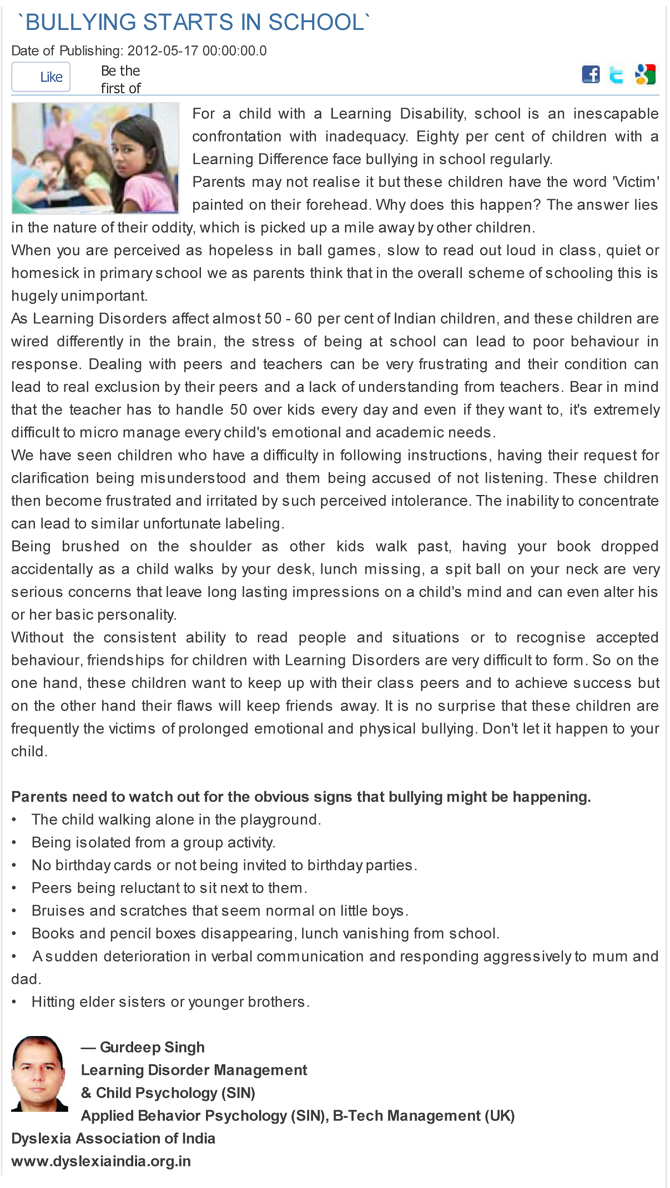
City Plus , 11-17 March 2012
Noida
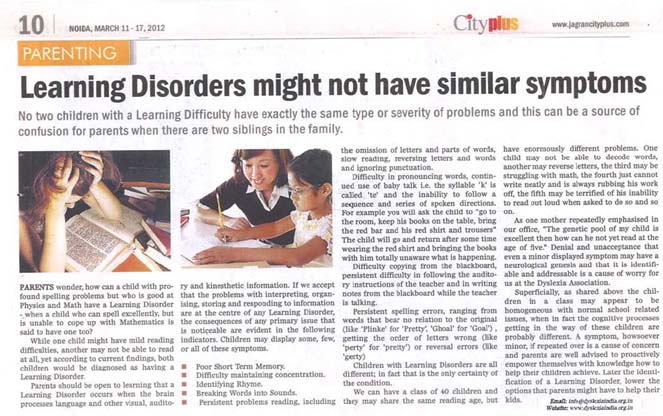
City Plus , 24-30 March 2012
Noida

City Plus , 2-8 March 2012
South Delhi
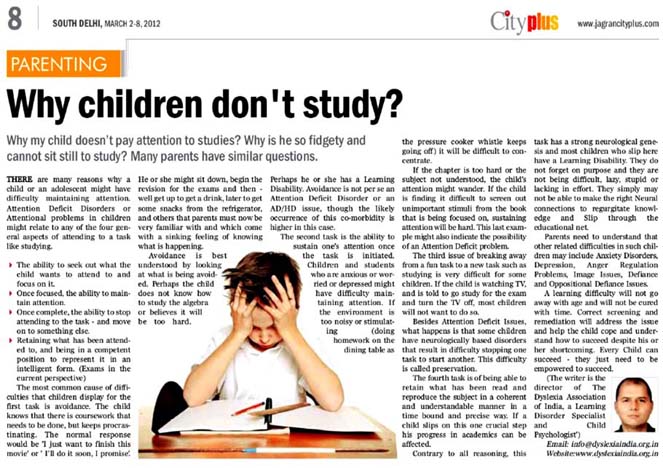
City Plus , 17-23 February 2012
South Delhi

Hindustan Times , 10 February 2012
Friday, New Delhi

Nai Duniya Media Pvt. Ltd., 20 january 2012
Friday, Noida

Hindustan Times, 20 january 2012
Friday, Noida

Hindustan, 10 january 2012
New Delhi
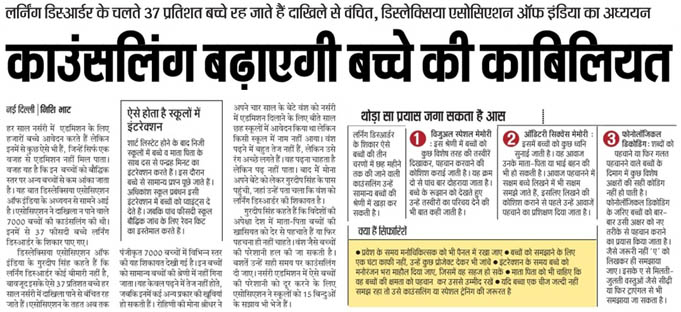
Sparkling others' lives (City Plus)
City Plus , Jun 1, 2012
Noida

Ignorance is not an option
Many parents agonize over whether to have their child assessed for Attention Deficit Disorders, because the picture isn’t necessarily simple or straightforward. The conflict stems from an overlap of what is normal childhood behaviour and when does misbehaviour merge into a Neurologically based issue. Let me share with parents that they can use the following steps to observe their children and then decide what the course of action should be.
If four or more of the following have persisted for at least six months then it is time to seek help.
⇒ The child often fails to give close attention to details or makes careless mistakes in schoolwork, work or other activities.
⇒ He or she has difficulty sustaining attention in tasks or play activities.
⇒ Often does not seem to listen when spoken to directly.
⇒ Often does not follow through on instructions and fails to finish schoolwork, chores or duties assigned.
⇒ Has difficulty organizing tasks and activities.
⇒ Avoids, dislikes, or is reluctant to engage in tasks that require sustained mental effort such as schoolwork or homework.
⇒ Loses things like toys, pencils, books, or lunch is eaten by friends.
⇒ Is often distracted by extraneous stimuli. Runs to open door when bell rings, picks up phone when it rings, starts sending sms while studying, taps pencil or pen on book, unable to sit still and must get up to go to the bathroom or the kitchen.
⇒ Is forgetful in daily activities. Cannot organize himself in the morning for school with going to school being a daily drama.
⇒ Blurts out answers before the question is completed.
⇒ Butts into conversations or games and has difficulty awaiting turn.
⇒ sIs fussy about food and will not sleep on time. Always has something to do or says ‘can’t you see I am busy’.
Parents should accept that normal children do not bounce all over and “extra energy” is not a normal phenomenon. ADHD is a life disability, affecting all aspects of life. It is a disability and like other chronic developmental disorders, the consequences of not recognizing, diagnosing and treating it can be extensive. Each stage of psychological and social development can be affected as can academic success, self esteem, and positive peer relationships. The resulting emotional social and family problems can become as great a disability for the adult as is the primary disability of ADHD. The secondary academic underachievement can have an impact on choice of career and future success with work. Such an impact influences both work happiness and future income.
Today an assessment does not need to carry a social stigma of being ‘different’. In fact an assessment can be the catalyst that can change your child’s life in no uncertain terms and may be the fulcrum that launches a child’s academic progress.
Dyslexia: Identification and treatment (Times of India)
On December 7, 2011, in Uncategorized, by Dare
Developmental reading disorder, or dyslexia, occurs when there is a problem in areas of the brain that help interpret language.
It is not caused by vision problems. The disorder is a specific information processing problem that does not interfere with one’s ability to think or to understand complex ideas. Most people suffering from dyslexia have normal intelligence, and many have above-average intelligence. This may appear in combination with developmental writing disorder and developmental arithmetic disorder. All of these involve using symbols to convey information. These conditions may appear alone or in any combination. Dyslexia is a genetic disorder, which may run in the families.
Study Sheds Light on Auditory Role in Dyslexia
By PAM BELLUCK
Published: August 1, 2011
Many people consider dyslexia simply a reading problem in which children mix up letters and misconstrue written words. But increasingly scientists have come to believe that the reading difficulties of dyslexia are part of a larger puzzle: a problem with how the brain processes speech and puts together words from smaller units of sound.
Now, a study published last week in the journal Science suggests that how dyslexics hear language may be
more important than previously realized. Researchers at the Massachusetts Institute of Technology have found that people with dyslexia have more trouble recognizing voices than those without dyslexia.
John Gabrieli, a professor of cognitive neuroscience, and Tyler Perrachione, a graduate student, asked people with and without dyslexia to listen to recorded voices paired with cartoon avatars on computer screens. The subjects tried matching the voices to the correct avatars speaking English and then an unfamiliar language, Mandarin.
Nondyslexics matched voices to avatars correctly almost 70 percent of the time when the language was English and half the time when the language was Mandarin. But people with dyslexia were able to do so only half the time, whether the language was English or Mandarin. Experts not involved in the study said that was a striking disparity.
“Typically, you see big differences in reading, but there are just subtle general differences between individuals who are afflicted with dyslexia and individuals who aren’t on a wide variety of tests,” said Richard Wagner, a psychology professor at Florida State University. “This effect was really large.”Dr. Sally Shaywitz, a director of the Center for Dyslexia and Creativity at Yale University, said the study “demonstrates the centrality of spoken language in dyslexia — that it’s not a problem in meaning, but in getting to the sounds of speech.”
That is why dyslexic children often misspeak, she said, citing two examples drawn from real life. “A child at Fenway Park watching the Red Sox said, ‘Oh, I’m thirsty. Can we go to the confession stand?,’ ” she said. “Another person crossing a busy intersection where many people were walking said, ‘Oh, those Presbyterians should be more careful.’ It’s not a question of not knowing, but being unable to attach what you know is the meaning to the sounds.”
Dr. Gabrieli said the findings underscored a critical problem for dyslexic children learning to read: the ability of a child hearing, say, a parent or teacher speak to connect the auditory bits that make up words, called phonemes, with the sight of written words.
If a child has trouble grasping the sounds that make up language, he said, acquiring reading skills will be harder.
The research shows that spoken language deficiencies persist even when dyslexics learn to read well. The study subjects were mostly “high-functioning, high-I.Q. young adults who had overcome their reading difficulty, ” Dr. Gabrieli said. “And yet when they had to distinguish voices, they were not one iota better with the English-language voices that they’ve heard all their life.”
Experts said the new study also shows the interconnectedness of the brain processes involved in reading. Many scientists had considered voice recognition to be “like recognizing melodies or things that are primarily nonverbal,” Dr. Gabrieli said. Voice recognition was thought to be a separate task in the brain from
understanding language.
But this research shows that normal reading involves a “circuit, the ability to have all of those components integrated absolutely automatically,” said Maryanne Wolf, a dyslexia expert at Tufts University. “One of the great weaknesses in dyslexia is that the system is not able to integrate these phoneme-driven systems” with other aspects of language comprehension.
As a follow-up, the M.I.T. researchers have been scanning the brains of subjects performing voice recognition and other activities, and have found “very big differences in dyslexics and nondyslexics in a surprisingly broad range of tasks,” Dr. Gabrieli said. “We think there might be a broader kind of learning that’s not operating very well in these individuals and that in some areas you can circumvent it pretty well. But in language and reading, it’s hard to circumvent.”
One of the unusual aspects of the M.I.T. study is that it isolated the skill of processing vocal speech from reading and from skills involving the meaning of language, experts said. The sentences were basic, like “The boy was there when the sun rose,” and the Mandarin sounds meant nothing to the listeners.
Dr. Wagner suggested that something like the voice-recognition task might be used to identify young children at risk for dyslexia.
Often diagnostic tests require separating sounds from words. A child might be asked to say “cowboy” without the “boy” part.
“For young children, it’s a real difficult task,” Dr. Wagner said. “Sometimes they’ll say, ‘cowboy without saying boy,’ because that’s exactly what you’ve asked them. The holy grail is to come up with tasks you can
give to a 3-year-old.”
Dr. Shaywitz said the study also has implications for teaching.If a teacher asked, “ ‘Oh, Johnny, what is the capital of New York State?,’ Johnny will go, ‘Uh, uh, uh,’ and the teacher will say, ‘Oh, gee, you don’t know it,’ ” Dr. Shaywitz said. “It’s more likely to be a problem of word retrieval than knowledge. If she reframes it as, ‘Is the capital Houston or Albany?,’ Johnny is more likely to answer correctly.”
Treat dyslexia as a handicap: Calcutta HC
HT Correspondent, Hindustan Times
Kolkata, July 18, 2011
The Calcutta high court on Monday ruled that dyslexics, or people with reading disorder, were entitled to be treated as handicapped.Justice Tapen Sen asked the Centre to amend the Persons With Disability Act 1995 by incorporating that dyslexia be treated as a handicap. According to the Act, 3% of total seats in each institution is reserved for the disabled.The directive came on a petition by Payel Sarkar, a dyslexia patient, challenging the denial of her admission at the Indian Institute of Hotel Management (IIHM) on the ground that dyslexic patients could not be treated as handicapped.
Justice Sen also held that dyslexics would not need any certificate from authorities, only their medical prescription would be enough to treat them as handicapped.
He directed IIHM to admit Sarkar and allow her to appear in the examination on the basis of her medical prescription.
Sarkar's advocates Subrata Mukhopadhyay and Kaushik Chandra welcomed the verdict."It will help dyslexics get admission to any educational institution of their choice...," said Mukhopadhyay.
Sarkar, a resident of Assam, had come to Kolkata in 2010 for treatment at the Calcutta Medical College. She was also admitted to Class 12 at the Kendriya Vidyalaya, but was not allowed to sit for examination because of poor attendance.
She had then moved the HC saying since she was a dyslexia patient she could not attend all the classes. Court had then directed the school to allow her to sit for exams. It had also directed the state and the Centre to formulate a policy for the benefit of dyslexic patients.
Neural networks involved in artistic creativity
Kowatari et al “Neural networks involved in artistic creativity” /
Human Brain Mapping. 2009 May;30(5):1678-90.
Abstract
Creativity has been proposed to be either the result of solely right hemisphere processes or of interhemispheric interactions. Little information is available, however, concerning the neuronal foundations of creativity. In this study, we introduced a new artistic task, designing a new tool (a pen), which let us quantitatively evaluate creativity by three indices of originality. These scores were analyzed in combination with brain activities measured by functional magnetic resonance imaging (fMRI). The results were compared between subjects who had been formally trained in design (experts) and novice subjects. In the experts, creativity was quantitatively correlated with the degree of dominance of the right prefrontal cortex over that of the left, but not with that of the right or left prefrontal cortex alone. In contrast, in novice subjects, only a negative correlation with creativity was observed in the bilateral inferior parietal cortex. We introduced structure equation modeling to analyze the interactions among these four brain areas and originality indices. The results predicted that training exerts a direct effect on the left parietal cortex. Additionally, as a result of the indirect effects, the activity of the right prefrontal cortex was facilitated, and the left prefrontal and right parietal cortices were suppressed. Our results supported the hypothesis that training increases creativity via reorganized intercortical interactions.
























India is a multilingual country. Each area is as diverse as the dialect that is spoken in the specific area. When a child is born, the first sounds he or she hears are the sounds of the language that are being spoken by the grandparents and the parents. Doting mothers and father’s leave no stone unturned to baby speak to the child to make him or her feel loved. Generous doses of expressive language love from grandparents who may or may not speak the same dialect reach the baby’s brain as stimulus. In this onslaught of stimulus, the small child’s brain is constantly trying to recognize what sound symbolizes which meaning.
India is a multilingual country. Each area is as diverse as the dialect that is spoken in the specific area. When a child is born, the first sounds he or she hears are the sounds of the language that are being spoken by the grandparents and the parents. Doting mothers and father’s leave no stone unturned to baby speak to the child to make him or her feel loved. Generous doses of expressive language love from grandparents who may or may not speak the same dialect reach the baby’s brain as stimulus. In this onslaught of stimulus, the small child’s brain is constantly trying to recognize what sound symbolizes which meaning.









